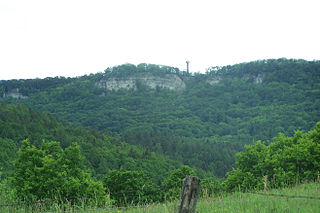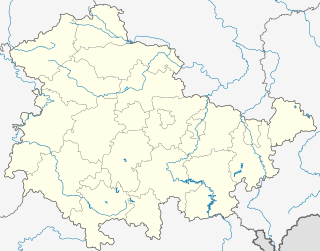Hennings Cave
| Hennings Cave
|
||
|---|---|---|
|
The rugged northern edge of the Heldrastein |
||
| Location: | Heldrastein near Treffurt , Thuringia | |
| Height : | 505 m above sea level NN | |
|
Geographic location: |
51 ° 6 '37 " N , 10 ° 11' 22.8" E | |
|
|
||
| Geology: | Cleft or cleft cavity | |
| Overall length: | unknown | |
The Henningshöhle is a legendary, now inaccessible cave on the Heldrastein near Treffurt in Thuringia .
location
The Heldrastein is the eastern part of an approximately eight kilometer long and steeply sloping north to the Werra , reaching across the forest village Dreiherrenstein , the Schäfersburg ( 481.7 m above sea level ) to the Graburg ( 514.8 m above sea level ) Shell limestone rock demolition. The remains of the Henningshöhle are located about 100 meters from the tower of the unit in the upper area of the northeastern edge of the rock face.
description
It is a fissure that was enlarged by weathering processes in the shell limestone, it was large enough to serve as a hiding place for robber captain Henning , a fugitive robber and criminal in the 18th century . While trying to descend to the cave unnoticed, Hermann Gehl , a ten-year-old schoolboy from Schnellmannshausen , had an accident on June 11, 1920 on a school trip. The boy fell to his death about 60 m deep on the rugged rock face. The cave was uncovered in 1936 at the instigation of the innkeeper from Heldrastein by a daring group of young boys, during which the cave clay was dug up and the cave was also measured for the first time. At this point in time it was possible to enter a room the size of a room, but its height was only about 1.80 meters. A kind of sintered structure or stalactite hung from the ceiling. The entrance to the cave itself was narrow and low. The cave is no longer accessible, since the 1960s, repeatedly weathered rock sections of the access and the front cave section to the valley broke.
Robber Henning
The namesake Florian Henning is said to have been born in Heldra in 1738 . In the poorhouse grew up, he knew what to do with life and joined the army. As a mercenary, he learned the soldier's trade during the Seven Years' War. Returning to Heldra, he was drawn to the solitude of the woods of the Heldrastein. He and some of his cronies spent the days in the Henningshöhle there. Raids as far as Eschwege and Mühlhausen / Thuringia are attributed to him. In Mihla there is an old tradition according to which Henning personally judged a crony who had become a traitor by hanging him. That should have happened Am Bach . Eventually hussars and farmers stormed the cave and captured Henning. He is said to have been executed in Mühlhausen.
A well-known legend tells how Henning was captured: He had kidnapped a young woman from the Werra Valley, she had to submit to him. Once she was given the opportunity to visit her mother in the valley. Before that, she had to swear a holy oath not to betray it: but the girl found a way out:
- “I am not allowed to tell anyone.
- But I want to complain to the stove:
- Up in the Henningsloch
- I bear the yoke of the robber! "
She used a bag of peas to mark an inconspicuous trail to the cave on the way home. It was possible to discover the robber's long-sought hiding place and to get hold of him.
Until August 1961, the Heldrastein plateau could still be reached by residents of the neighboring Thuringian towns Schnellmannshausen , Scherbda , Treffurt , Großburschla , Falken , Volteroda , Ifta and Creuzburg ; it was a popular destination and was particularly popular on the summer and autumn weekends. A daring climbing path led from the former restaurant to the Hennings cave .
The area around the cave has since been designated a nature reserve, rare birds breed here, and bats live in the crevices. In the exhibition area of the Hüneburg there are several explanatory panels on the history of the Heldrastein, they also show pictures from the pre-war period, on which the rock sections of the cave are shown.
Web links
- The Heldrastein - website of the responsible homeland and nature conservation association
Individual evidence
- ^ Geyer, Jahne, Storch: Geological sights of the Wartburg district and the independent city of Eisenach . In: District Office Wartburgkreis, Lower Nature Conservation Authority (Hrsg.): Nature conservation in the Wartburgkreis . Booklet 8. Printing and publishing house Frisch, Eisenach and Bad Salzungen 1999, ISBN 3-9806811-1-4 , p. 26–27 and cover picture .
- ↑ Official topographic maps of Thuringia 1: 10,000. LK Gotha, Wartburgkreis, district-free city of Eisenach . In: Thuringian Land Survey Office (Hrsg.): CD-ROM series Top10 . CD 2. Erfurt 1999.
- ↑ Helmut Grimm et al: Legends, fairy tales and stories from Treffurt and the surrounding area . Frisch Druckerei, Eisenach, S. 64 .
- ↑ Gerhard Kühn: From the history of the Heldrastein (part 4) In: Werratalbote, May 9, 2016
- ^ NN: (news) stalactite cave on the Heldrastein . In: Thüringer Heimatschutzbund (Hrsg.): Thüringer Heimatschutz, supplement to the Thüringer Fähnlein . 6th episode. Jena 1937, p. 48 .
- ↑ a b c Interest group Heldrastein eV (Ed.): The Heldrastein . Friedrich-Gajewski-Druckhaus and Verlag, Ringgau-Datterode 1997, ISBN 3-930342-06-5 , p. 120-127 .
- ^ Rainer Lämmerhirt Robber Henning and other robber stories , in: Werratalnachrichten, Mitteilungsblatt der Gemeinde Mihla ..., year 1998, number 6, p. 15


